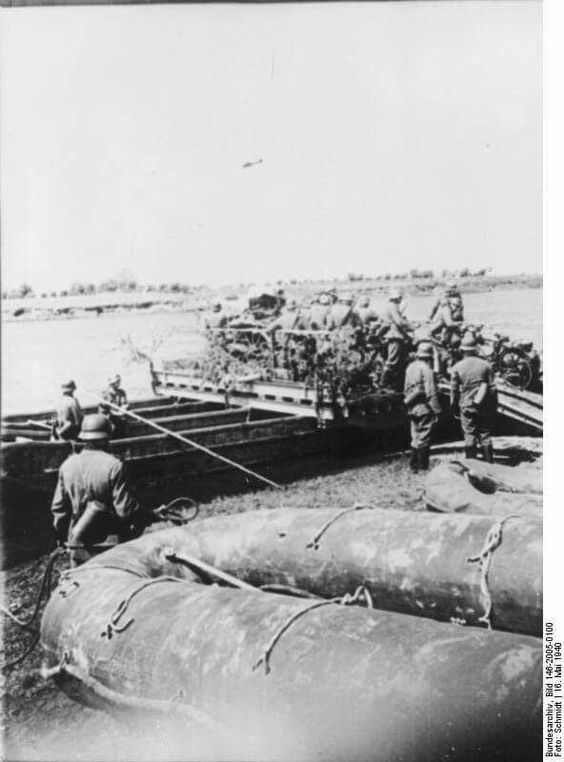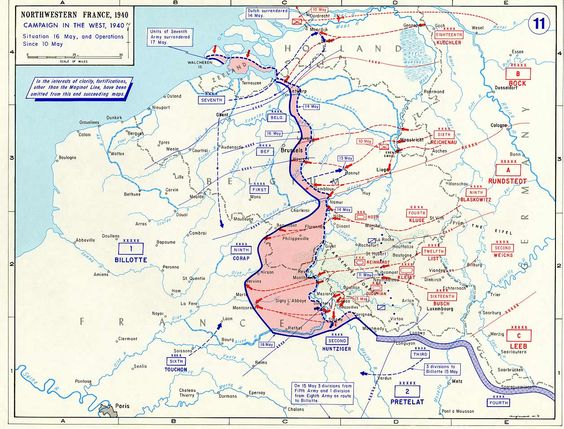Sunday 19 May 1940
 |
| Belgian tank on fire in Zwyndrecht, Antwerp, Belgium. 19 May 1940. |
Lord Gort, head of the BEF, has a conversation with General Edmund Ironside, the British Chief of the Imperial General Staff. Ironside recommends attacking southwest toward Amiens. Lord Gort replies that he has insufficient troops, as 7 of his 9 divisions are in action on the Scheldt. Somewhat bizarrely, Gort relates that his putative French commander, General Billotte of the 1st Army Group, has not issued him any orders in a fortnight.
Ironside then talks to General Billotte, who is nearby. He finds that Billotte is incapable of taking action. Ironside returns to England convinced that the end is near for the BEF and ramps up anti-invasion efforts. A code name is generated for a BEF evacuation: Operations Dynamo.
Much of the German Panzer force has been halted between Péronne and St. Quentin for refueling, maintenance, and re-supply. Today, General Guderian starts moving forward again. He takes Péronne, only 50 miles from the French coast. This disrupts the supply lines of the BEF and French forces fighting to the north.
General Rommel regroups at Cambrai.
Brigadier General de Gaulle launches his second attack from Laon into the German spearhead flank at Montcornet using the 4th Armoured Division. Once again, as on the 17th, he makes some progress, but the effort runs out of steam. However, there is no corresponding thrust from the other side of the bulge which might cut off the most advanced German units.
The Belgian army withdraws in the sector including St Nicholas, Lakeren, and Audenard.
The BEF pulls back near Lille.
On the Maginot Line, the German 71st Infantry Division, after a three-day battle, take the left-most anchor of the line, Fort La Ferté (known as Panzerwerk 505 to the Wehrmacht). The French inside succumb to the smoke and toxic fumes after their ammunition and other items catch fire. The fort, 20 km south of Sedan on a hill overlooking the Chiers River, has been blocking the German advance. The Germans occupy the village of Villy. Underneath Villy, the fort had been scaled back during construction due to cost, making it a death trap for the 107 soldiers inside.
European Air Operations: Fliegerkorps VII is covering the German advance toward Abbeville. This is a key component of "Blitzkrieg." There are radio-equipped forward liaison Luftwaffe officers traveling with the panzers who have direct lines to the Luftwaffe bases. The amount of time between a request for air support and its arrival is minimal, around 10 minutes for Henschel HS 123s and 45-75 minutes for the Ju 87 Stukas.
The Luftwaffe bombs Royal Navy destroyer HMS Whitley, which must be beached and scuttled.
The Luftwaffe bombs Dieppe.
The Luftwaffe also is supporting the attacks on the Maginot Line in the south. They are hitting fortresses and helping the ground to make progress against this supposedly invulnerable line.
The RAF once again bombs oil refineries in the Ruhr.
The RAF begins pulling its last squadrons in Belgium. They have lost over half of their aircraft and the German army is approaching their airfields. BEF air cover will be conducted henceforth from bases in England.
There are reports that 100,000 people perished in the Rotterdam air attacks, with a third of the city destroyed. This figure is likely wildly exaggerated for propaganda purposes, but then again, nobody knows how many people died. The high figure illustrates the depths of fear and terror being sown by the innovative Blitzkrieg. Rotterdam has joined "Warsaw" on the litany of Luftwaffe misdeeds chronicled in Allied propaganda.
 |
| Luftwaffe Junkers Ju 87 unit near Arras, France. May, 1940 (Strift, Federal Archive). |
Royal Navy minelayer HMS Princess Victoria hits a mine and sinks in the North Sea.
Convoy OA 151 departs from Southend, Convoy OB 151 departs from Liverpool, and Convoy OG 30 forms at Gibraltar.
Norway: The evacuation of Mo i Rana concludes, with the last rearguard troops of B Company of the Scots Guard and No. 1 Independent Company pulling out. The German 2d Mountain Division occupies the town and sends troops further north toward Bodo.
Military Intelligence: The cryptoanalysts at Bletchley Park crack the Enigma "Red" code being used by the Luftwaffe liaison officers to coordinate ground support.
Anglo/US Relations: Winston Churchill sends President Roosevelt a plea for quick aid while discussing something else. "If [the old destroyers] were here in 6 weeks, they would play an invaluable part."
Sweden: The government announces that, like Great Britain, it will form its own home defense corps. It also institutes gasoline rationing.
Ethiopia: A group of Italian settlers arrives.
War Crimes: Civilians live in fear of Allied troops who reportedly are shooting civilians who they are mistaking for German paratroopers or infiltrators. There are other anecdotal reports of Allied troops shooting civilians who they believe, for one reason or another, to be aiding the German advance.
British Homefront: Prime Minister Winston Churchill makes an address to the British people which he calls " Be ye men of valor," which is a quotation from 1 Maccabees in the Apocrypha. Churchill mentions that only "a very small part" of the French army has been engaged with the Germans, but that it would be "foolish ... to disguise the gravity of the hour." He vows to "wage war until victory is won, and never to surrender ourselves to servitude and shame, whatever the cost and the agony may be."
American Homefront: Charles Lindbergh makes another radio broadcast in support of isolationism:
"We need not fear a foreign invasion unless American peoples bring it on through their own quarreling and meddling with affairs abroad. If we desire peace, we need only stop asking for war. No one wishes to attack us, and no one is in a position to do so."
 |
| A commemorative day for war heroes of the Winter War in Joensuu, Finland. 19 May 1940 (SA-kuva). |
May 1940
May 1, 1940: British Leave ÅndalsnesMay 2, 1940: British Depart Namsos
May 3, 1940: Many Norwegians Surrendering
May 4, 1940: Bader Returns
May 5, 1940: HMS Seal Survives
May 6, 1940: Allies Focus on Narvik
May 7, 1940: In The Name of God, Go!
May 8, 1940: Exit Chamberlain
May 9, 1940: Enter Churchill
May 10, 1940: Fall Gelb
May 11, 1940: Eben Emael Surrenders
May 12, 1940: Germans at Sedan
May 13, 1940: Rommel at Work
May 14, 1940: German Breakout in France
May 15, 1940: Holland Surrenders
May 16, 1940: Dash to the Channel
May 17, 1940: Germans Take Brussels
May 18, 1940: Germans Take Antwerp
May 19, 1940: Failed French Counterattack
May 20, 1940: Panzers on the Coast
May 21, 1940: Battle of Arras
May 22, 1940: Attacking Channel Ports
May 23, 1940: British Evacuate Boulogne
May 24, 1940: Hitler's Stop Order
May 25, 1940: Belgian Defenses Creaking
May 26, 1940: Operation Dynamo
May 27, 1940: King Leopold Surrenders
May 28, 1940: The Allies Take Narvik
May 29, 1940: Lille Falls
May 30, 1940: Operation Fish
May 31, 1940: Peak Day for Dynamo
2020





